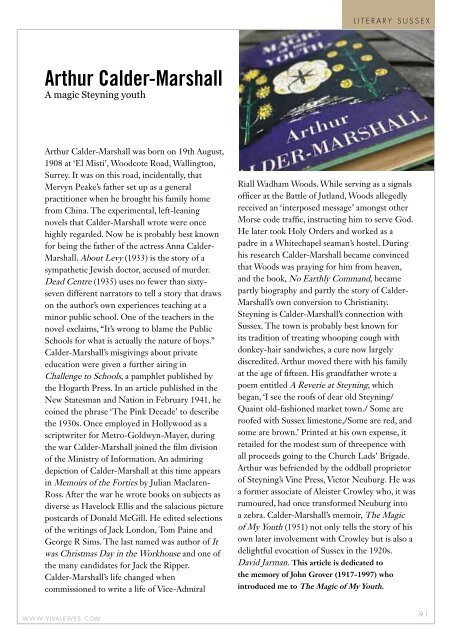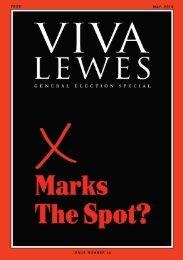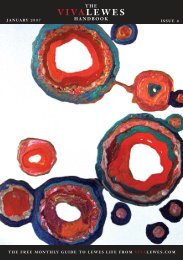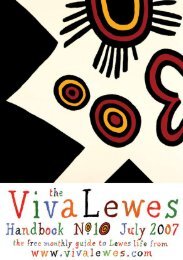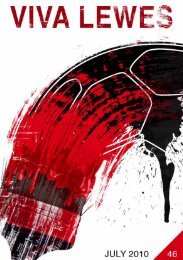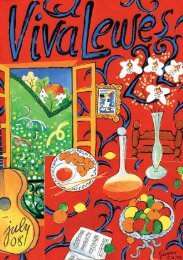Call us now on: 0800 731 5905 - Viva Lewes
Call us now on: 0800 731 5905 - Viva Lewes
Call us now on: 0800 731 5905 - Viva Lewes
Create successful ePaper yourself
Turn your PDF publications into a flip-book with our unique Google optimized e-Paper software.
arthur calder-Marshall<br />
A magic Steyning youth<br />
Arthur Calder-Marshall was born <strong>on</strong> 19th Aug<str<strong>on</strong>g>us</str<strong>on</strong>g>t,<br />
1908 at ‘El Misti’, Woodcote Road, Wallingt<strong>on</strong>,<br />
Surrey. It was <strong>on</strong> this road, incidentally, that<br />
Mervyn Peake’s father set up as a general<br />
practiti<strong>on</strong>er when he brought his family home<br />
from China. The experimental, left-leaning<br />
novels that Calder-Marshall wrote were <strong>on</strong>ce<br />
highly regarded. Now he is probably best k<str<strong>on</strong>g>now</str<strong>on</strong>g>n<br />
for being the father of the actress Anna Calder-<br />
Marshall. About Levy (1933) is the story of a<br />
sympathetic Jewish doctor, acc<str<strong>on</strong>g>us</str<strong>on</strong>g>ed of murder.<br />
Dead Centre (1935) <str<strong>on</strong>g>us</str<strong>on</strong>g>es no fewer than sixtyseven<br />
different narrators to tell a story that draws<br />
<strong>on</strong> the author’s own experiences teaching at a<br />
minor public school. One of the teachers in the<br />
novel exclaims, “It’s wr<strong>on</strong>g to blame the Public<br />
Schools for what is actually the nature of boys.”<br />
Calder-Marshall’s misgivings about private<br />
educati<strong>on</strong> were given a further airing in<br />
Challenge to Schools, a pamphlet published by<br />
the Hogarth Press. In an article published in the<br />
New Statesman and Nati<strong>on</strong> in February 1941, he<br />
coined the phrase ‘The Pink Decade’ to describe<br />
the 1930s. Once employed in Hollywood as a<br />
scriptwriter for Metro-Goldwyn-Mayer, during<br />
the war Calder-Marshall joined the film divisi<strong>on</strong><br />
of the Ministry of Informati<strong>on</strong>. An admiring<br />
depicti<strong>on</strong> of Calder-Marshall at this time appears<br />
in Memoirs of the Forties by Julian Maclaren-<br />
Ross. After the war he wrote books <strong>on</strong> subjects as<br />
diverse as Havelock Ellis and the salacio<str<strong>on</strong>g>us</str<strong>on</strong>g> picture<br />
postcards of D<strong>on</strong>ald McGill. He edited selecti<strong>on</strong>s<br />
of the writings of Jack L<strong>on</strong>d<strong>on</strong>, Tom Paine and<br />
George R Sims. The last named was author of It<br />
was Christmas Day in the Workho<str<strong>on</strong>g>us</str<strong>on</strong>g>e and <strong>on</strong>e of<br />
the many candidates for Jack the Ripper.<br />
Calder-Marshall’s life changed when<br />
commissi<strong>on</strong>ed to write a life of Vice-Admiral<br />
w w w. V I VA l E w E s . C o M<br />
l I t E r A r y s U s s E x<br />
Riall Wadham Woods. While serving as a signals<br />
officer at the Battle of Jutland, Woods allegedly<br />
received an ‘interposed message’ am<strong>on</strong>gst other<br />
Morse code traffic, instructing him to serve God.<br />
He later took Holy Orders and worked as a<br />
padre in a Whitechapel seaman’s hostel. During<br />
his research Calder-Marshall became c<strong>on</strong>vinced<br />
that Woods was praying for him from heaven,<br />
and the book, No Earthly Command, became<br />
partly biography and partly the story of Calder-<br />
Marshall’s own c<strong>on</strong>versi<strong>on</strong> to Christianity.<br />
Steyning is Calder-Marshall’s c<strong>on</strong>necti<strong>on</strong> with<br />
S<str<strong>on</strong>g>us</str<strong>on</strong>g>sex. The town is probably best k<str<strong>on</strong>g>now</str<strong>on</strong>g>n for<br />
its traditi<strong>on</strong> of treating whooping cough with<br />
d<strong>on</strong>key-hair sandwiches, a cure <str<strong>on</strong>g>now</str<strong>on</strong>g> largely<br />
discredited. Arthur moved there with his family<br />
at the age of fifteen. His grandfather wrote a<br />
poem entitled A Reverie at Steyning, which<br />
began, ‘I see the roofs of dear old Steyning/<br />
Quaint old-fashi<strong>on</strong>ed market town./ Some are<br />
roofed with S<str<strong>on</strong>g>us</str<strong>on</strong>g>sex limest<strong>on</strong>e,/Some are red, and<br />
some are brown.’ Printed at his own expense, it<br />
retailed for the modest sum of threepence with<br />
all proceeds going to the Church Lads’ Brigade.<br />
Arthur was befriended by the oddball proprietor<br />
of Steyning’s Vine Press, Victor Neuburg. He was<br />
a former associate of Aleister Crowley who, it was<br />
rumoured, had <strong>on</strong>ce transformed Neuburg into<br />
a zebra. Calder-Marshall’s memoir, The Magic<br />
of My Youth (1951) not <strong>on</strong>ly tells the story of his<br />
own later involvement with Crowley but is also a<br />
delightful evocati<strong>on</strong> of S<str<strong>on</strong>g>us</str<strong>on</strong>g>sex in the 1920s.<br />
David Jarman. This article is dedicated to<br />
the memory of John Grover (1917-1997) who<br />
introduced me to The Magic of My Youth.<br />
9 1


